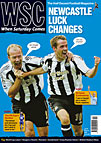 The MLS was formed two decades after the NASL finished. Graham Hughes reports that it's still going strong ten years on
The MLS was formed two decades after the NASL finished. Graham Hughes reports that it's still going strong ten years on
The long-term significance
Twelve years after the North American Soccer League (NASL) had fizzled out, a new professional league was launched in the United States. As part of the agreement to stage the 1994 World Cup, FIFA had insisted on a “Division One” league being formed. Despite persistent financial losses and a failure to make a major impact in the American sports world, MLS has enjoyed far more stability than its chaotic predecessor and approaches its tenth anniversary in reasonably healthy shape.
Story of the season
Ten franchises were created, in areas that had been identified as promising markets for soccer. In an attempt to avoid the problems that had plagued the NASL – competitive imbalance, excessive salaries and a dearth of home-grown talent – the league had an unusual “single entity” structure. The whole MLS, including the clubs, was (and still is) a single limited-liability company, with the league administrators owning the players’ contracts and keeping tight control over transfers. “Investor-operators” were installed at the franchises, cringe-worthy team names were coined (New York/New Jersey MetroStars, Dallas Burn, and so on), sponsorship and TV deals were struck, rules were tinkered with, players were allocated to teams, and – two years later than originally planned – MLS got underway in April 1996.
The teams were divided into Eastern and Western Conferences. Draws were to be settled by shoot-outs, where each player had to dribble the ball from 35 yards out and beat the keeper (the winners only gained one point, rather than three; the experiment was dropped after the 1999 season). The Tampa Bay Mutiny topped the eastern table, with the Los Angeles Galaxy leading the way in the west. But this counted for little, as the top four teams in each conference moved on to the play-offs, eliminating just two teams. DC United and Los Angeles came through the play‑offs to reach the championship decider, MLS Cup ’96. DC came back from 2-0 down to win 3-2, the decisive goal coming from centre-back Eddie Pope in the fourth minute of sudden-death extra time.
For the record books
The first MLS goal was scored by USA striker Eric Wynalda, in a 1-0 home win for the San Jose Clash against DC United on April 6. Tampa Bay’s Roy Lassiter was the regular season’s top scorer, with 27 goals in 30 games, a league record to this day. Colombia’s Carlos Valderrama, a team-mate of Lassiter’s, won the “most valuable player” award. Los Angeles had the highest average attendance, 28,916, while the league average was 17,406 – a figure that hasn’t been equalled since, although the average per season has hovered quite respectably around the 15,000 mark.
Same place today
Nine of the ten original teams are still in MLS, largely as there is no relegation, an alien concept in the US. But they have all stayed in the same cities for a decade – a rare achievement for a new American league in any sport. The San Jose Earthquakes (née Clash) and Kansas City Wizards, though, are likely to move before long.
Moved furthest away
After a failed bid to persuade a certain Glazer family to bail it out, the Tampa Bay franchise was shut down following the 2001 season, together with the Miami Fusion (added to the league in 1998, along with the Chicago Fire), having struggled to draw crowds in the notoriously difficult Florida sports market.
Went on to great things
Bruce Arena ~ Coached DC United to the league’s first two titles and to another MLS Cup appearance in 1998. Arena then took the reins of the United States national team and led them to the quarter‑finals of the 2002 World Cup.
Brad Friedel and Brian McBride ~ Columbus Crew team-mates, both now established in the Premiership.
Carlos Queiroz ~ Became the MetroStars coach in May, before moving to Grampus Eight in Japan at the end of the season. Now whinges in BBC interviews on behalf of Alex Ferguson.
Disappearing from view
Americans abroad ~ Seeing a chance to play in a credible league in their own country, Alexi Lalas, Cobi Jones and John Harkes and others left overseas clubs.
Indoor leagues ~ Facing new competition, professional indoor soccer went into decline. Two leagues closed down by 2001; only the six-team Major Indoor Soccer League survives.
Frank Stapleton ~ The former Arsenal and Manchester United striker resigned as New England Revolution coach, after they finished bottom of the Eastern Conference. He hasn’t had a major coaching job since, but is at least a regular Sky pundit.
From WSC 228 February 2006. What was happening this month